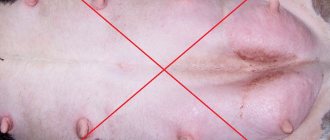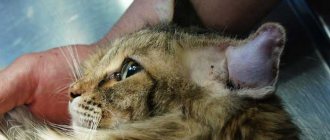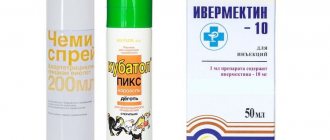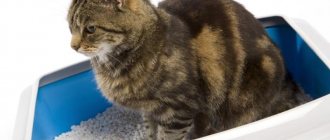General information about the disease
Pyoderma can appear as a result of infection in wounds and cuts on the skin or as a result of advanced allergic dermatitis. The cause of the inflammatory process is the entry into the body of bacteria streptococcus, Pseudomonas aeruginosa, and staphylococcus. Small pustular formations filled with cloudy liquid are observed on the animal’s skin. In some cases, the cat's hair falls out and bald patches form.
With pyoderma, bald patches and scabs appear on the cat's skin.
With timely diagnosis, treatment at home will not be difficult. The risk group includes old, weakened animals. Young animals that receive irregular and poor-quality nutrition, with insufficient vitamins and minerals, may also suffer from pyoderma.
Symptoms and signs (with photos)
As the disease progresses, cats experience severe baldness. For this reason, pyoderma can be confused with ringworm. Depression, weakness, and increased body temperature are often observed. The animal may refuse to eat.
The presence of pyoderma in cats is indicated by:
- numerous scabs;
- papules and pustules;
- ulcers that are filled with cloudy contents;
- hair loss;
- covering the skin with hard, small scales;
- change in skin color;
- severe itching accompanied by constant scabies;
- formation of alopecia foci;
- suppuration and inflammation of skin areas.
After some time, erosions form on the affected areas, which further aggravates the situation.
Important!
If you have any symptoms of illness, be sure to visit your veterinarian immediately!
Reasons for the development of the disease
There are many factors that lead to the development of pyoderma in cats. First of all, these are wounds and scratches on the skin, ringworm or thyroid disease (hyperthyroidism). Pyoderma can be triggered by fleas or lice, improper grooming (especially in long-haired cats), frequent bathing of the cat, demodicosis, immunodeficiency virus, long-term use of chemotherapy and steroid drugs, and allergic reactions.
The cause of the disease may be a lack of vitamin A and tocopherol in the diet. Therefore, it is very important to provide your pet with high-quality and balanced nutrition with the addition of special vitamin complexes.
Why does pathology develop?
Pyoderma occurs when pyogenic bacteria, those that cause purulent-serous inflammation in the process of life, enter and activate on the damaged skin of cats. These include:
- Pseudomonas aeruginosa;
- streptococcus;
- staphylococcus;
- coli;
- Klebsiella
The disease develops against the background of allergic reactions.
The main causes of the disease are the following factors:
- decreased immunity;
- wounds, scratches;
- allergies accompanied by rashes;
- infection with skin parasites (Demodex mites, fleas);
- lack of vitamins and minerals;
- metabolic disorders in which sebum production increases;
- hormonal disbalance;
- uncontrolled treatment of their animals with medications by the owners;
- diabetes;
- frequent bath procedures, which disrupt the natural lubrication of the skin.
Clinical signs
Pyoderma is usually divided into 2 types: superficial and deep. With superficial pyoderma, damage to the upper layer of the dermis and hair follicles are observed. In the deep form of pyoderma, the infection affects the deepest layers of the skin, causing furunculosis and inflammation of the fatty tissue.
The main signs of the disease are:
- constant incessant itching;
- alopecia (baldness of certain areas of the skin);
- the appearance of small scales on the surface of the skin;
- ulcers on the stomach, paws and face of the cat;
- in advanced cases, a hard and dense scab appears.
The deep form of pyoderma is characterized by the appearance of copious purulent discharge, large affected areas, fever, anorexia, and lethargy. In advanced cases, sepsis and death may develop.
Symptoms
Signs may vary. Pustules or papules, plaques, ulcers and erosions appear on the skin. Pyoderma is characterized by:
- unpleasant odor from the skin;
- pronounced redness at the site of inflammation;
- the fur sticks together with exudate (pus) with the formation of scabs, crusts, hair falls out;
- itching varies from mild to severe.
There are 2 types of superficial pyoderma depending on which anatomical structures of the skin are affected:
- Impetigo is microabscesses inside or under the stratum corneum of the epidermis.
- Folliculitis is the development of infection in the hair follicles.
Impetigo is more common in kittens, and folliculitis is more common in adult animals.
How dangerous is the disease for cats?
Pyoderma can lead not only to a sharp decrease in immunity, but also cause the development of a large number of concomitant diseases. Constant scratching of ulcers is fraught with deep damage to the skin, the formation of colloidal scars on which hair no longer grows. If treatment is not started in a timely manner, the cat develops sepsis, which, in most cases, leads to the death of the animal.
Many cat owners want to know whether feline pyoderma is contagious to humans. Experts say there is no reason to worry. After all, the disease develops exclusively in animals with weakened immunity or as a secondary disease. Only ringworm is dangerous to humans.
What are the complications?
If treatment is delayed, pyoderma in cats can have dangerous consequences, such as:
- Abscess. The pathology is accompanied by the formation of a purulent cavity, which leads to the melting of skin structures. The disease is dangerous due to tissue death, the development of sepsis and death.
- Phlegmon. It is characterized by diffuse purulent inflammation with the formation of areas of necrosis. The disease leads to inflammation of the lymph nodes, erysipelas, and general infection of the body.
- Damage to internal organs. If the infection enters the blood, the pathogenic microflora can affect the brain, heart, and kidneys. The most common diagnoses are bacterial meningitis, myocarditis, and glomerulonephritis. These conditions are fatal.
- Sepsis. Through foci of inflammation on the skin, the infection spreads through the bloodstream throughout the body and provokes death.
Diagnosis of pyoderma in cats
When making a diagnosis, it is important to accurately identify the presence of bacterial pyoderma. After all, its symptoms are often similar to those of demodicosis or a fungal infection. To diagnose the disease, a skin scraping is taken and sent for cytological examination. Some experts recommend conducting a serological blood test for the presence of the immunodeficiency virus.
A general and hormonal blood test must be taken. This allows you to determine dysfunction of the thyroid gland and the general condition of the animal. To diagnose deep pyoderma, you will have to do a skin biopsy to determine the source of bacterial infection.
To diagnose pyoderma, it is necessary to take a scraping.
Etiology of appearance
The disease is preceded by mechanical damage to the skin of the animal. If there are cuts and scratches on your pet's skin, there is a possibility of infection getting into them.
Reference!
Pathogenic microorganisms develop pathogenic microflora, which leads to the formation of painful, purulent inflammations.
All cats are susceptible to infections, regardless of age and breed. However, most often it is young and old individuals with weak immune systems who get sick.
The disease is preceded by mechanical damage to the skin of the animal. If there are cuts and scratches on your pet's skin, there is a possibility of infection getting into them.
Reference!
Pathogenic microorganisms develop pathogenic microflora, which leads to the formation of painful, purulent inflammations.
All cats are susceptible to infections, regardless of age and breed. However, most often it is young and old individuals with weak immune systems who get sick.
Reference!
Treatment of the disease
At the first suspicion of pyoderma, you should definitely contact a veterinarian. Only he can correctly diagnose the disease and prescribe proper therapy. At the initial stage of the disease, the animal must be assigned to hospital treatment.
Before starting treatment, the cat's hair is carefully cut off from the affected areas and treated with chlorhexidine, potassium permanganate or iodine solution. This procedure will help disinfect the surface of the skin and remove the resulting scab. After which it is possible to use antibacterial ointments, for example, Baneocin, Mupirocin or Bacitracin.
Important. The main therapy for deep pyoderma is the use of antibiotics. Usually very strong drugs are prescribed, in high dosages. Therefore, during the period of treatment, the cat must be under the supervision of a doctor.
Antibiotics such as Amoxicillin, at a dose of 8 mg/kg of animal weight, 2 times a day, with an interval of at least 12 hours, or Erythromycin, at a dosage of 20 mg/kg, every 8 hours, are often used. Often, 2 such drugs are used at once. The doctor may also prescribe intramuscular administration of Cefadroxil (22 mg/kg, once a day) or Sulfadiazine (20 mg/kg, 2 times a day). The course of treatment cannot be less than 2 months.
The affected areas are cut off and treated with chlorhexidine.
For small affected areas, antibiotics may not be used; superficial local treatment will be sufficient. Do not forget about regular skin treatment with chlorhexidine. To improve the general condition of the animal, the doctor may prescribe intramuscular injections of immunostimulants (Aminovital or Gamavit) and complex vitamin preparations. An autovaccine is sometimes used to speed up recovery.
If the affected areas occupy a large area of the skin, then it will not be possible to do without the use of antibiotics. In this case, Clindamycin will help, at a dosage of 20 mg/kg body weight, once a day, or Ronidazole (30 mg/kg, also once a day). These drugs have a strong antimicrobial effect and quickly relieve the cat’s condition.
Treatment at home
If the disease is mild and there is no need for regular injections, there is no need to keep the cat in the hospital. Treatment can be carried out at home. It will consist of regularly treating the pustules with antibacterial ointments and adding vitamin and mineral preparations to the diet. It is important to remember that all medications must be used within a week after the symptoms of the disease disappear. After which, to monitor recovery, the skin is scraped again.











